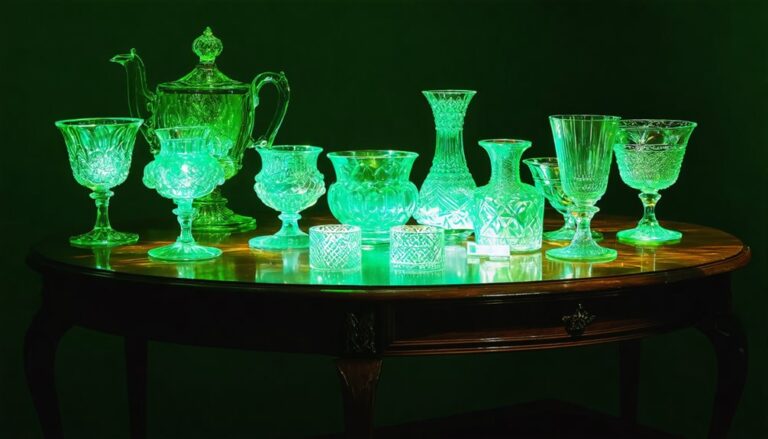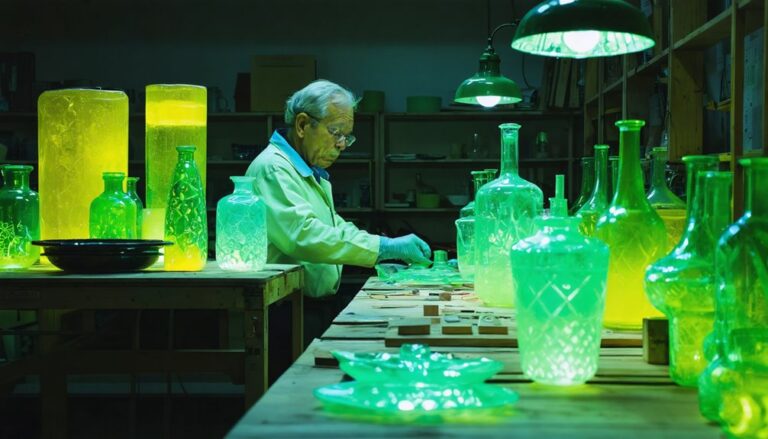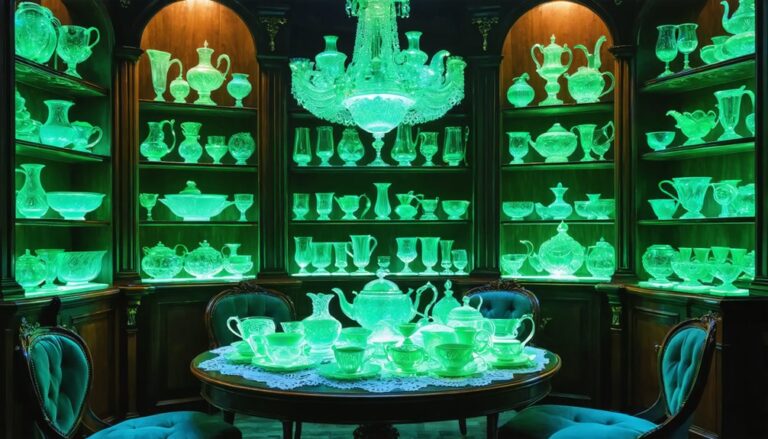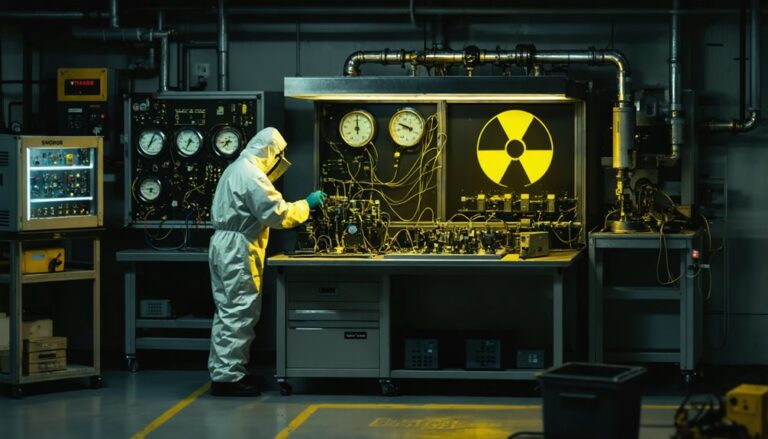Exploring the Use of Uranium in Art Glass Techniques
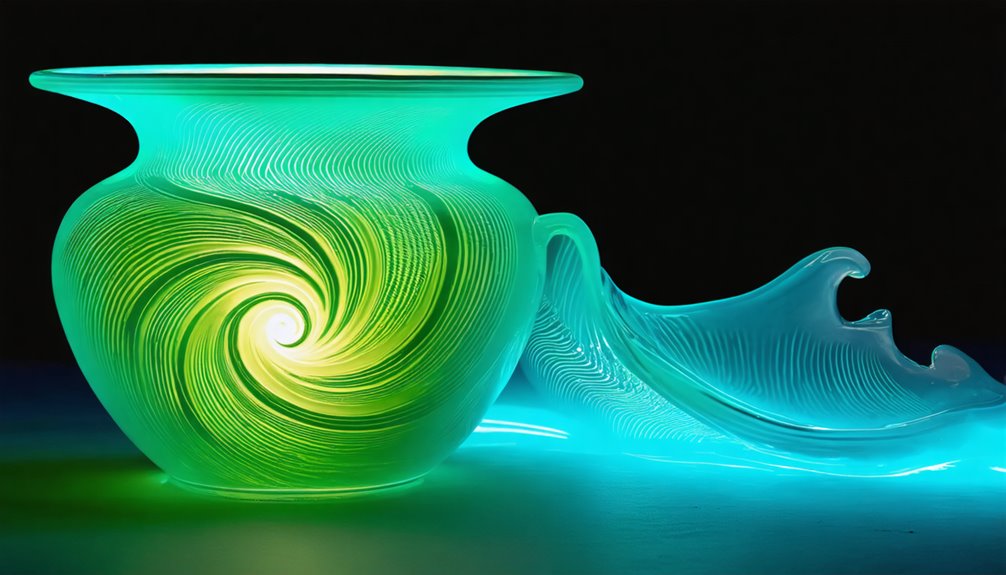
I have always found it fascinating how glassmakers combine science and creativity using uranium compounds. They create vibrant shades of green and yellow that glow under ultraviolet light. This practice started in the 19th century. Glass artisans began experimenting with uranium oxide, leading to bright fluorescence. The popularity of uranium glass peaked during the Art Deco period.
Companies like Bagley and Cambridge were key players. They crafted intricate designs through various methods, including pressing, etching, and cutting. Each piece showcases the skill and imagination of the artisans. Collectors today cherish these items for their unique charm and rich history.
There is much to learn about uranium glass. Topics such as safety, preservation, and the collector community are essential. Understanding these aspects can enhance appreciation for this art form.
Key Takeaways
Uranium oxide first appeared in glassmaking during the early 19th century. Craftsmen used it to create striking yellow-green hues in decorative glass pieces. By adjusting the amount of uranium oxide and adding other elements like cobalt or manganese, glassmakers produced a range of colors and intensities. This allowed for a versatile palette in their creations.
Techniques such as pressing, etching, and cutting emerged to showcase intricate designs. These methods highlighted the unique glow of uranium glass when exposed to ultraviolet light, making the pieces even more captivating.
In the 1920s and 1930s, Art Deco designers embraced uranium glass. They crafted bold geometric shapes and vibrant colors, leading to a surge in popularity. Collectors sought after these distinctive items, which became symbols of the era’s artistic flair.
Over time, manufacturers began to reduce the amount of uranium in their glass. Safety concerns played a significant role in this shift. As a result, the production techniques and popularity of uranium glass changed, reflecting a growing awareness of health risks associated with its use.
Historical Origins of Uranium in Art Glass
When we think about uranium, we often picture nuclear reactors or radioactive materials. But uranium also has an interesting past in art glass. This story began in the early 19th century. In the 1830s, a glassmaker named Josef Reidel started using uranium salts in his factory in Bohemia. He created stunning glass pieces that glowed in bright green and yellow colors. These vibrant hues quickly caught the attention of collectors and the public.
By the 1880s, uranium glass became widely popular. The Whitefriars Glass Company played a significant role in this trend by mass-producing beautiful items. Their creations showcased the unique colors and drew in many buyers.
During the Art Deco era, uranium glass reached new heights in design. Artists loved how it glowed under ultraviolet light, giving it an enchanting quality.
Despite its charm, concerns about safety led to restrictions on uranium’s use in glassmaking. Over time, this limited the production of uranium glass. However, it still stands as a symbol of creativity and skill in manufacturing.
The development of techniques to incorporate uranium salts changed the glass industry, allowing artists to explore new forms and colors. Today, uranium glass remains a fascinating example of how science and art can come together.
The Chemistry Behind Uranium Glass Colors
Uranium glass has a rich history that dates back to the 1830s. Artisans discovered that adding uranium oxide to glass could create striking colors. The vibrant yellow-green shade became popular among glassmakers. They used different amounts of uranium, sometimes reaching 25% by weight, to achieve various hues.
This glass isn’t just beautiful. It also has a special property. Under ultraviolet light, uranium glass glows with a bright green fluorescence. This happens because uranium absorbs UV rays and re-emits them as visible light. This fascinating aspect made uranium glass highly sought after for both decorative pieces and practical items.
During the 19th and 20th centuries, manufacturing techniques evolved to enhance the production of uranium glass. Factories developed new methods to incorporate uranium oxide smoothly into the glass mixture. These advancements allowed for more consistent colors and improved durability. As a result, uranium glass became a staple in households and was often used for tableware and decorative items.
Over the years, the popularity of uranium glass has fluctuated. While it was trendy in the mid-20th century, concerns about radioactivity have led to a decline in its use.
However, collectors still cherish these pieces for their unique beauty and historical significance. Understanding the development of manufacturing techniques helps explain why uranium glass continues to be appreciated today.
Uranium Oxide Coloration
Uranium glass, often known as Vaseline glass, has a fascinating history rooted in the development of manufacturing techniques. This unique glass contains uranium oxide, which provides it with its distinctive yellow-green hue. The color can vary from a soft glow to a bold, rich green. This variation depends on the amount of uranium oxide used during the melting process.
In the 19th century, glassmakers discovered that adding uranium oxide to their glass mixtures created not only beautiful colors but also a unique fluorescence. This glow occurs naturally, even without special treatment. The result was a prized material for decorative arts, captivating artists and collectors alike.
As glassmaking techniques evolved, artisans learned how to adjust the concentration of uranium in their mixtures. They could deepen the color and create various shades. This control over the glass allowed for greater creativity. By adding other elements like manganese or cobalt, glassmakers expanded their color palette. This innovation led to striking variations in their work, enhancing the visual appeal of their creations.
Uranium glass became popular for many decorative items, from tableware to ornamental pieces. Its appeal lay not only in its vibrant colors but also in the novelty of its radioactive properties.
While modern safety standards have changed how uranium glass is produced, its legacy remains strong in the art world. Today, collectors appreciate both its beauty and its historical significance.
Fluorescence Under UV
Uranium glass has a captivating history that intertwines with the development of manufacturing techniques. This unique glass has been produced since the 1830s. Early glassmakers discovered that adding uranium oxide to glass could enhance its color and create a distinct fluorescence under ultraviolet light. This vibrant glow occurs when the uranium absorbs UV rays and emits a bright green light.
Manufacturing techniques evolved over the years. Initially, artisans created uranium glass by mixing uranium oxide with silica and other materials. As demand grew, factories began using more efficient methods to produce larger quantities.
By the time Art Deco emerged in the 1920s, uranium glass became a popular choice for decorative items. The intense glow and striking appearance captured the attention of collectors.
The level of uranium in the glass determines its fluorescence intensity. Low uranium content produces a pale green glow, while medium levels yield a bright green. High uranium content results in an intense and vivid green. Collectors often seek pieces with higher uranium concentrations for their remarkable luminescence.
While uranium is slightly radioactive, its contribution to the glow is minimal. The real magic lies in the interaction of uranium ions with the glass during the melting process. This interaction creates a dazzling array of colors and visual appeal.
Uranium glass remains a fascinating example of how innovation in manufacturing can lead to extraordinary results.
Art Deco and Uranium Glass: A Perfect Match
Uranium glass has an interesting history that dates back to the early 19th century. Manufacturers discovered that adding uranium to glass not only enhanced its color but also gave it a unique glow when exposed to ultraviolet light. This discovery led to the creation of vibrant green and yellow glass, which became popular in the 1920s and 1930s.
During this time, companies like Bagley and Cambridge produced amazing designs. They transformed everyday items into eye-catching pieces. The bold geometric shapes and striking patterns of Art Deco style paired well with the radiant qualities of uranium glass. This combination made the glassware desirable for collectors.
The manufacturing techniques for uranium glass evolved over the years. Glassmakers learned to mix uranium oxide with other materials to achieve different hues and effects. This innovation allowed for greater creativity in design.
Today, collectors and enthusiasts admire these glass pieces for their beauty and the fascinating fluorescence that appears under black light. They aren’t just ordinary household items; they’re collectibles with a rich history.
The blend of Art Deco design and uranium glass continues to captivate many.
Geometric Patterns and Shapes
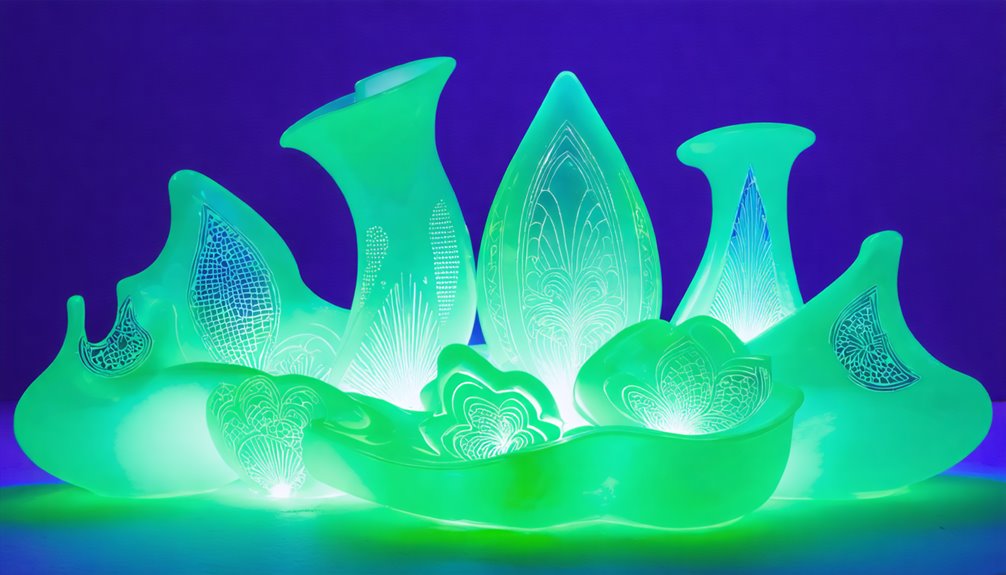
Uranium glass, often admired for its vibrant glow, has a fascinating history rooted in innovative manufacturing techniques. This unique glass, infused with uranium oxide, gained popularity in the early 20th century. It was during this time that the Art Deco movement emerged, emphasizing bold geometric patterns and streamlined shapes.
Manufacturers like Walther and Söhne showcased remarkable skill in crafting uranium glass pieces. One standout example is the Greta vase. This piece artfully combined frosted and clear uranium glass, resulting in intricate geometric designs. The infusion of uranium oxide did more than just add color; it enhanced the glass’s vibrancy, especially under UV light.
The geometric patterns in these pieces represented the Art Deco ideal of balancing form and function. They conveyed a sense of modernity and elegance. The designs featured bold shapes and distinct symmetry. The contrast between frosted and clear glass added to their visual appeal.
Glowing Glass Collectibles
Uranium glass, often associated with the Art Deco era, has a fascinating history. This unique collectible combines visual allure with scientific intrigue. The glass glows a vibrant green when exposed to UV light, making it a standout piece in any collection.
Manufacturers like Bagley, Cambridge, and Walther and Söhne were pioneers in creating these remarkable glass items. They perfected pressed glass techniques during the 1920s and 1930s, producing decorative pieces that were both affordable and visually compelling. Their craftsmanship allowed these items to be mass-produced, increasing their availability to collectors.
The uranium content in these glass pieces can be as high as 25%. Despite this, the radioactivity levels are minimal, making them safe for collectors. This aspect adds to their charm, as they aren’t only beautiful but also carry a story of scientific discovery and innovation.
Today, the value of uranium glass varies widely. Prices can range from $10 to $500. Factors influencing the price include rarity, design complexity, and condition.
Collectors appreciate these items not only for their aesthetics but also for their historical significance. The development of manufacturing techniques during the Art Deco period has left a lasting impact on the world of collectibles.
Notable Manufacturers and Designers of Uranium Glass
Uranium glass isn’t just a pretty sight; it tells a story of innovation and craftsmanship. Several key manufacturers and designers played a crucial role in shaping its history.
Bagley stands out as an English pioneer. Known for their stunning Art Deco creations, the Grantham vase and the Rose Leaf plate showcase how bright and lively uranium glass can be. Their work truly highlights the glass’s unique qualities.
Across the ocean, the Cambridge Glass Company made a significant mark in America. They became famous for their Decagon collection, which features bold lightning bolt handles. This collection represents a shift towards modern design and the playful use of uranium glass.
In France, Legras made waves in the 1920s with their daring Art Deco style. Their geometric designs, such as the Versailles model, elevated the allure of uranium glass. They embraced new techniques that brought a fresh perspective to glassmaking.
Meanwhile, Stölzle emerged as a significant player from Austria and Czechoslovakia in the 19th century. Their Rocket vase stands out as a beautiful example of uranium glass’s elegance.
Stölzle’s work spans various styles and periods, demonstrating the material’s versatility and timeless appeal.
These manufacturers and designers not only produced beautiful items but also advanced the techniques used in creating uranium glass. Their innovations helped transform a simple material into an art form that continues to fascinate collectors and enthusiasts today.
Uranium Glass Varieties and Their Visual Effects
Uranium glass has a rich history that dates back to the early 19th century. Initially, glassmakers experimented with uranium oxide to create a unique color and fluorescence. This marked the beginning of a fascinating journey in glass manufacturing.
Vaseline glass is one of the most notable varieties. It has a pale yellow-green hue that resembles petroleum jelly. When exposed to ultraviolet light, it reveals a brilliant green glow. This effect is due to the uranium content, which fluoresces under UV light.
Custard glass is another interesting type. It has a creamy, opaque appearance and also glows brightly under UV light. The manufacturing techniques used to create this glass evolved over time, allowing for the production of stunning pieces that are now sought after by collectors.
Blue and pink uranium glass are rarer forms. These colors are achieved through the addition of specific metal oxides during the glass-making process. Each color variation showcases the creativity and innovation of glassmakers throughout history.
Depression glass, which often contains uranium, combines historical importance with aesthetic appeal. These pieces not only fluoresce dramatically under UV light but also tell a story of the Great Depression era in the United States. Their significance adds to the allure for collectors and history enthusiasts alike.
Techniques Used in Crafting Uranium Glass
Uranium glass has a fascinating history that dates back to the early 19th century. The incorporation of uranium oxide into glass began around the 1830s. This technique was revolutionary, allowing artisans to create vibrant glassware that glowed under ultraviolet light. The unique properties of uranium made it a popular choice among glassmakers.
Uranium glass emerged in the 1830s, captivating artisans with its vibrant glow and innovative use of uranium oxide in glassmaking.
When it comes to manufacturing, pressing is a key technique. This method utilizes molds to form intricate designs, reminiscent of the elegant Art Deco style. It requires skill to achieve delicate patterns, showcasing the craftsmanship of the era. By adjusting the mixture, glassmakers can add colorants to achieve striking variations, such as deep blues or soft pinks. These hues increase the appeal of the products.
Finishing techniques play a significant role in enhancing the final appearance of uranium glass. Etching creates detailed patterns, adding a sense of luxury. Frosting gives a soft texture, making pieces feel sophisticated. Cutting requires precision and reflects the artisan’s expertise. Each finishing touch elevates the glass, making it suitable for both decoration and practical use.
Moreover, the properties of uranium enhance the glass’s durability and heat resistance. This versatility allowed it to be used in various applications, from stunning collectibles to everyday items.
The journey of manufacturing uranium glass is a blend of art and science, resulting in unique pieces cherished by collectors and enthusiasts alike.
Safety and Health Perspectives of Uranium Glass Artistry
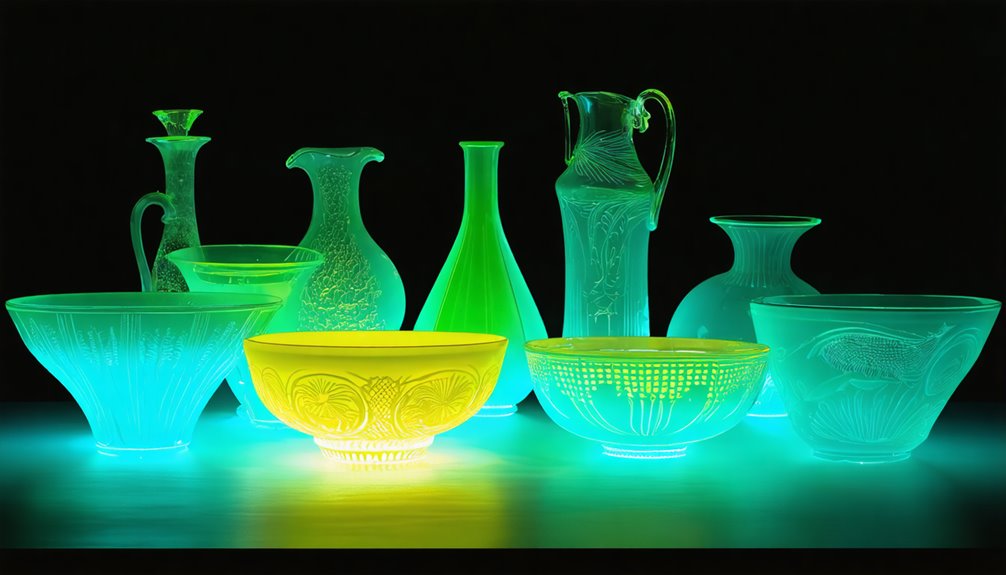
Uranium glass has a fascinating history tied to the development of manufacturing techniques. This unique glass became popular in the 19th century when artisans discovered that adding uranium to glass could create a striking green or yellow hue, along with a captivating glow under ultraviolet light. The process of incorporating uranium oxide into glass was relatively simple and allowed for the production of both decorative and functional items.
As the demand for uranium glass grew, manufacturers refined their techniques. They learned how to mix uranium with other materials to enhance the glass’s aesthetic appeal while maintaining safety standards. The glass was often used for making beautiful tableware, vases, and decorative pieces, each showcasing the skilled craftsmanship of the era.
Despite its popularity, the safety concerns surrounding uranium glass became apparent over time. While the radiation levels are generally low, awareness of potential health risks led to changes in manufacturing and usage guidelines.
Today, collectors and artists appreciate the beauty of uranium glass but are also mindful of its properties. Handling it with care remains essential. Using uranium glass for food or drink isn’t advisable due to the risk of contamination.
Collecting and Preserving Uranium Glass Pieces
Uranium glass has a storied history that dates back to the early 19th century. Initially, manufacturers used uranium as a colorant in glass production. The glass was prized for its vivid green hue and distinctive fluorescence under UV light. This unique glow made it popular among collectors and decorative arts enthusiasts.
Manufacturing techniques evolved over time. Early glassmakers experimented with different types of uranium compounds to achieve varying colors and effects. By the late 1800s, uranium glass was widely produced, especially in the United States and Europe. Factories developed innovative methods to incorporate uranium without compromising the glass’s clarity and beauty.
During the 20th century, the use of uranium glass peaked. It became a staple for household items like dishes and decorative pieces. However, concerns over radioactivity began to surface. As a result, manufacturers adjusted their recipes, often using lower uranium content or replacing it altogether.
Today, collecting uranium glass is a fascinating hobby. Enthusiasts appreciate the craftsmanship and history behind each piece. They often seek out rare items from specific eras or manufacturers. This interest has led to a resurgence in the appreciation of uranium glass, making it a vibrant part of collector culture.
Collectors should remember the importance of safety. While the radiation levels are low, it’s wise to handle these pieces with care. Understanding the history and development of manufacturing techniques enhances the enjoyment of this unique glassware.
Frequently Asked Questions
How Is Uranium Used in Glass?
Uranium glass, also known as Vaseline glass, has a fascinating history. It became popular in the 19th century when glassmakers discovered the unique properties of uranium. They found that adding small amounts of uranium to glass created bright green or yellow hues. This vibrant color attracted collectors and artists alike.
Manufacturing techniques for uranium glass evolved over time. Early glassmakers used uranium oxide to enhance color. Later, they refined their methods, allowing for more intricate designs and patterns. The glass became a staple in decorative arts, showcasing both beauty and craftsmanship.
Safety is important when working with uranium glass. While it contains low levels of radiation, modern standards ensure that it is safe for display. Collectors can appreciate the historical significance and aesthetic appeal of these pieces without worry.
Why Is Uranium Glass Illegal?
Uranium glass, often known as Vaseline glass, has a fascinating history. This unique type of glass contains about 2% uranium, which gives it a distinct green or yellow hue and allows it to fluoresce under ultraviolet light.
The manufacturing of uranium glass began in the early 19th century. Artisans experimented with different materials to create vibrant colors. The addition of uranium was a way to enhance the glass’s appearance. This innovation led to a surge in popularity during the Victorian era and continued into the 20th century.
However, health concerns arose over time. The presence of uranium, even in small amounts, raised questions about safety. Regulations regarding uranium glass emerged as a response to these concerns. While it isn’t fully illegal, strict guidelines govern its production and sale.
Today, collectors are often drawn to uranium glass due to its unique characteristics and historical significance. The market for this glass remains steady, fueled by both nostalgia and the thrill of collecting. Safety measures are essential, though, as they ensure that collectors can enjoy their pieces without health risks.
Is Glass With Uranium Worth Anything?
Uranium glass, known for its distinctive green or yellow hue and its ability to fluoresce under ultraviolet light, has a fascinating history. Its creation began in the early 19th century when glassmakers discovered that adding uranium oxide to glass could enhance its color and brightness. This unique process made uranium glass especially popular during the Art Deco period in the 1920s and 1930s.
As time went on, manufacturing techniques improved. Glassmakers learned to manipulate the amount of uranium used, resulting in a variety of styles and designs. Some pieces were made for everyday use, while others were crafted as decorative art. Collectors often seek out rare designs or those with historical significance, which can drive up their value.
Safety regulations have also shaped the market for uranium glass. While the levels of radiation in these pieces are generally low and considered safe, awareness of safety has influenced collector interest. Today, many people appreciate uranium glass for its aesthetic qualities rather than its radioactive properties.
Collectors should understand current market trends. Prices can fluctuate based on rarity and demand. Some pieces can fetch a high price, especially if they are part of a well-known collection or have unique features. Knowledge about the history and development of manufacturing techniques can provide valuable insights for anyone interested in buying or selling uranium glass.
How Do You Tell if There Is Uranium in Glass?
To identify uranium in glass, it helps to understand its history and the development of manufacturing techniques. Uranium glass, often called Vaseline glass, became popular in the late 19th and early 20th centuries. Manufacturers used uranium to create vibrant colors and to enhance the glass’s glow under ultraviolet light.
When examining glass, you can use a UV light. If the glass fluoresces a bright green or yellow, it likely contains uranium. This simple method helps collectors and enthusiasts spot potential pieces of uranium glass.
Knowledge of historical glass production also plays a crucial role. Many companies used uranium in their glassware, especially during the Art Deco period. Understanding these trends can guide collectors in identifying valuable pieces.
Safety regulations regarding uranium have changed over time. Early glassmakers used uranium without concern for health risks, but modern regulations are stricter. Today, knowing the history of uranium glass helps in both collecting and ensuring safety.
Conclusion
Uranium glass has an intriguing history that blends science, art, and culture. This glass, containing about 2% uranium by weight, was popular from the 1830s until the 1940s. It caught the eye of glassmakers due to its unique properties. When exposed to ultraviolet light, it glows a striking green color. This visual effect makes uranium glass highly sought after by collectors and artists.
The manufacturing techniques of uranium glass evolved over the years. Early glassmakers experimented with adding uranium to their mixtures, discovering that it not only enhanced color but also improved clarity. The process involved melting silica and other materials alongside uranium compounds, creating a vibrant and appealing product. This glass became a staple in homes, used for everything from tableware to decorative items.
Safety has always been a concern with uranium glass, but with proper handling and storage, it can be enjoyed without fear. Many people today appreciate its historical significance and artistic value. Collectors often seek out specific pieces, and artists find inspiration in its unique glow. Understanding the chemistry behind uranium glass helps to preserve this captivating craft for future generations.
